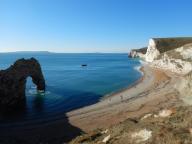


individuele reizen
Devon en Dorset - 9 dagen
The Jurassic Coast: Exmouth to Weymouth and Lulworth Cove
zwaarte 
Het merendeel van de kustlijn van Oost-Devon en Dorset is nog onaangetast; prachtig gekleurde kliffen - rode leisteen, witte kalksteen en gele zandsteen. De nederzettingen onderweg zijn karaktervol: de lieflijke Victoriaanse badplaats Sidmouth, het mooie dorp Beer waar de vissersboten het kiezelstrand opgetrokken worden, Lyme Regis met zijn steile straten en middeleeuwse havenmuur, Abbotsbury met zijn tiendschuur en zwaan (beide middeleeuws) en de 15e eeuwse Sint-Catharinakapel, de drukke haven van Weymouth. Deze zuidkust staat bekend om zijn milde en zonnige klimaat waar het hele jaar door gewandeld kan worden. De route is goed beschreven en de dagafstanden van 12 tot 20 km zijn niet inspannend. De tour is geschikt voor redelijk fitte wandelaars met weinig of geen wandelervaring.
De kenmerkende gekleurde kliffen van deze kust zijn van internationaal belang vanwege de bijna volledige geologische profielen door Mesozoïsche lagen, in het bijzonder de Jura, die ze tonen. De kust is gemakkelijk toegankelijk is voor wandelaars via het South West Coast Path.
Day program:
Daily stages, with distances, heights and approximate walking times.
Walking times are estimated for an average walker, omitting breaks for rests and visits to points of interest en route.
Day 1. Arrive Exmouth. Exmouth, in a beautiful setting at the mouth of the estuary of the River Exe, is a typical English seaside holiday resort. You can explore the town and beach on foot. If you arrive very early there could also be time for an excursion by train to Exeter (historic city centre and cathedral).
Day 2. Walk Exmouth to Sidmouth. 20km/12.5 miles/6 hours walking time. Ascent/descent 390m/1280 feet. Highest point 157m/515 feet (Peak Hill).
A failrly gentle introduction to English coast path walking. However, as the day proceeds the hills get higher and the views longer. Mostly you follow the crest of the red cliffs, but at the ancient port of Budleigh Salterton, from where Walter Raleigh set off to the Carolinas, you descend to sea level to cross the river Otter. The day can be shortened by using buses to reduce the distance, time and height gain/loss. But we recommend persevering - you have all day to get there!
Day 3. Walk Sidmouth to Beer. 14.2km/8.8miles/5 hours walking time. Ascent/descent 610 m (2000 feet). Highest point 162m/531 feet (Weston Cliff).
For most of the day you follow the crest of red cliffs, with several abrupt descents to cross the deep wooded combes. The repeated short steep ascents and descents are unavoidably strenuous. Take your time! Those fond of animals will only need to make a short detour from the coast path to visit the famous donkey sanctuary, where up to 400 retired donkeys live a life of leisure. Entry free every day. Beyond Branscombe the colour of the cliffs changes abruptly to the intense white of the chalk of Beer Head. The brilliant white chalk cliffs overlook Beer’s delightful sheltered beach, where fishing boats are still winched up the shingle.
Day 4. Walk Beer to Lyme Regis. 13.7km/8.5 miles/4.5 hours walking time. Ascent/descent approximately 400m/1300 feet. Highest point 120m/393 feet (Barn Close Lane). The going through the magnificent sub-tropical jungle of the Undercliff is often slow. The undergrowth is so dense that often you can hear the sea but not see it. The path is in places subject to landslips and detours may be required. Note: in 2014 a short but critical section of the Undercliff footpath was closed for more than 2 years on account of landslips, making it temporarily impossible to walk the whole section from end to end. The path was fully repaired and re-opened by 2017, but temporary detours and closures of this and other sectors of the coast path are always possible
Options for a day in Lyme Regis (J5 tour). Options include exploring the fascinating town with its steep main street and ancient harbour wall (the famous 'Cobb', which features in both Jane Austen's 'Persuasion' and John Fowles' 'The French Lieutenant's Woman'). Or you can walk the next stretch of roller-coaster cliffs between Charmouth and West Bay and return by bus from West Bay or from an intermediate point to Lyme (see below: ‘Day 5 hiking option’). The bus service operates once per hour, on Sundays (except in winter) every 2 hours. Or just wander along the shore from Lyme to look for fossils (care needed on account of tides – we provide tide tables!) We also provide hints on where to find some of the best fossils.
Day 5. Lyme Regis to West Bay (Bridport harbour). 16km/10 miles/6 hours walking time. Ascent/descent 730m/2400 feet (100m less ascent if starting walk from Morcombelake). Highest points 190m/620 feet (Chardown Hill and Golden Cap). A superb day, one of the best on the whole of the South West Coast Long Distance Trail. Magnificent views. The first part of the coastal path, from Lyme Regis to Charmouth is diverted inland across agolf course because of coastal erosion. To avoid this diverted section we advise taking a bus either to Charmouth or Morecombelake, from either of which you can walk via Stonebarrow to rejoin the coast path at Cain’s Folly. On Sundays in early and late season when the bus service is limited, we provide a transfer from Lyme Regis either to Ship Knapp, Morcombelake (the recommended starting point of the walk to West Bay) or to your accommodation in West Bay. The going is strenuous, with sustained ascents and descents, but the walk can be shortened by walking inland from Seatown to the bus route at Chideock.
Overnight West Bay.
Day 6. West Bay (Bridport) to Abbotsbury. 14.5km/9 miles/4.5 hours walking time. Ascent/descent 320m (1050 feet). Highest point 215m/705 feet (Abbotsbury Hill Fort).
An easier day. From the coastal village of West Bexington you have the choice between striking inland to follow a high chalk ridge to the iron age hill fort of Abbotsbury Castle (magnificent panorama over Chesil Beach towards Portland) or staying on the coast, where you follow part of the pebble ridge known as Chesil Beach and then cut inland past the sub-tropical Abbotsbury gardens and the 15th C hill-top chapel of St Catherine to the picturesque stone built village of Abbotsbury.
Abbotsbury is famous for its swannery (swan reserve, open to the public, fee payable) where the wild birds have been protected since mediaeval times. During the nesting season the birds can nest anywhere within the reserve, including the paths, and may even allow visitors to step over them as they sit on their nests - the only place in the world where swans are trusting enough to permit this.
Overnight Abbotsbury.
Day 7. Abbotsbury to Weymouth .
From Abbotsbury we describe two alternative routes.
1. The Fleet route (coast path) to Ferrybridge. 17km/10.5 miles/5 hours walking time. Ascent/descent approx.150m/500 feet. Highest point 75m/246 feet (Merry Hill). Staying close to the coast you follow a sometimes muddy path over low hills to reach the shore of the lagoon known as the Fleet - the setting for the children’s novel 'Moonfleet' by - then follow the mostly level winding shore of the long brackish lagoon to meet the road and bus route linking Weymouth with Portland at Ferrybridge. It is also possible to continue along the rather suburban section of coast path from Ferrybridge to Weymouth, adding another 4km/2.5 miles. The Fleet route is attractive for bird-watchers, and is of considerable geomorphological interest, but lacks dramatic scenery.
2. Inland route to Maiden Castle and. 16km/10 miles/4.5 hours walking time, plus up to an hour to explore Maiden Castle. Ascent/descent approx. 350m/1150 feet. Highest point 239m/785 feet (Blackdown Hill).A dramatic and scenic alternative route, mostly following the South Dorset Ridgeway National Trail, strikes inland from Abbotsbury along the crest of a chalk ridge to reach the lofty hilltop of Blackdown, crowned by a monument dedicated to a certain Thomas Hardy; surprisingly this was not the celebrated novelist, but 'Nelson's Hardy’, who accompanied the admiral at the battle of Trafalgar. From Blackdown you continue along the chalk ridges to meet the Dorchester -Weymouth bus route near the immense and spectacular Romano-British hill fort of Maiden Castle - open to the public at all times. Just below the concentric banks of the fort is the tiny village of Winterbourne Monkton, from where you can catch a frequent bus to Weymouth. We provide bus info and indicate the bus stops on the maps.
Overnight Weymouth.
Day 8 . Weymouth (Bowleaze cove) to Lulworth Cove 13.5km/8.5 miles/4.5 hours. Height gain/loss approx. 550m/1800 feet. Highest point White Nothe (165m/541 feet).
We now end the J8 tour with 2 nights in Weymouth rather than having the final night at Lulworth Cove. One night stays at Lulworth have become very hard to book, especially at weekends, and we have found that many people prefer to have a second night in Weymouth, which has good rail connections as well as sjhopping opportunities.
We still recommend that you walk the outstandingly scenic section of coast path from Weymouth to Lulworth Cove. We provide a taxi ride back from Lulworth Cove to Weymouth in the afternoon. Highlights on the way include the so-called ‘burning cliff’ above Ringstead, where at times the oil-rich shales can undergo spontaneous combustion; the view from the high chalk promontory of White Nothe (in former times, when the atmosphere was clearer, reputed to have been the westernmost point in England from which France could be seen); and the rock arches of Durdle Door and Bats’ Hole;. There are refreshment possibilities at Osmington (for a coffee break) and Ringstead (for an early lunch). Overnight Weymouth.
Day 9. Depart Weymouth. Frequent daily train service to London Waterloo via Bournemouth, Southampton, Southampton Airport, Woking (for bus link to Heathrow Airport). Less frequent trains to Bristol.
If returning to Exmouth (for instance to collect your car) it may be best to book a taxi for the whole journey as the train route is long, slow and expensive, involving 2 changes of train (at Castle Cary and Exeter St David’s). It is also possible to take a direct bus from Weymouth to Axminster rail station and continue from there by train to Exmouth (but still necessary to change once at Exeter); or to do the whole h journey from Weymouth to Exmouth by bus, changing buses twice (at Lyme Regis and Sidmouth). However all this alternatives will be much slower than the taxi ride, which should take about 1.5 hours.
zoeken in
filteropties

